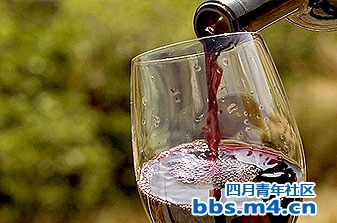|
|
本帖最后由 woikuraki 于 2012-4-1 09:52 编辑
【中文标题】中国人的红酒情节
【原文标题】China's love for red wine
【原载媒体】印度斯坦时报
【原文链接】http://www.hindustantimes.com/Entertainment/Food/China-s-love-for-red-wine/Article1-833546.aspx
 A sample of red wine at "Domaine Du Baal" winery in the city of Zahle.
A sample of red wine at "Domaine Du Baal" winery in the city of Zahle.
While China is drinking more and more wine each year it appears also that consumers are drinking more and more of the same type of wine.
According to a recent survey produced to help promote May's Vinexpo Asia-Pacific event -- the largest wine industry gathering in the region -- 99.5 percent of wine drunk in China is still wine, and 91 percent of the still wine drunk is red wine. And that's a trend Vinexpo CEO Robert Beynat says "won't change for a long time."
China's fixation with red wine is reflected by the demand and prices being paid for the likes of Lafite-Rothschild 1982, a case of which was bought by a Chinese buyer for a record HK$1.03 million ($132, 770) at an auction last year.
French wine imports into China were multiplied by seven times from 2006 to 2010, according to the Vinexpo survey, while consumption of wines from Australia, the country's second largest supplier and another producer noted for its red varieties, increased by 3.9 times over the same period.
The most popular wines are the stronger varieties with Wine Australia last year reporting that Shiraz was its best seller in China (half of all sales) followed by Cabernet Sauvignon and Merlot.
Red wine surpassed traditional Chinese liquor as the most popular alcoholic drink in China last year, according to the Ipsos research group, when it accounted for 39 percent of the market, with the growth attributed to more Chinese drinking wine regularly, with meals or at bars, rather than just at special occasions.
A recent report in the state-run China Daily newspaper claimed the Chinese wine consumer was "driven heavily by advertising, with top producers running mass-marketing campaigns to build brand awareness. This brand-driven environment, with a lack of emphasis on taste preferences, has also affected the market for foreign wine."
And a report on the Chinese wine industry commissioned by the Singaporean government last year found "the profile of the average wine drinker is someone who is in their mid-20s to 30s, and who is aspiring to a more sophisticated lifestyle."
Interestingly the Singapore government also claimed that the "Chinese's taste for tea could explain why red wine is popular since the tannins in tea are exactly the same as those found in red wine."
But Beynat believes as the Chinese market grows so too -- eventually -- will Chinese tastes.
"The interest of Chinese consumer in wine is becoming more and more important," Beynet explained. "Thanks to Chinese wine production, which is growing fast, the consumption will become more democratic. Wine lovers will become more and more educated in wine and this knowledge will encourage them to diversify their taste."
Vinexpo Asia Pacific will be held at the Hong Kong Convention and Exhibition Centre from May 29-31.
|
|